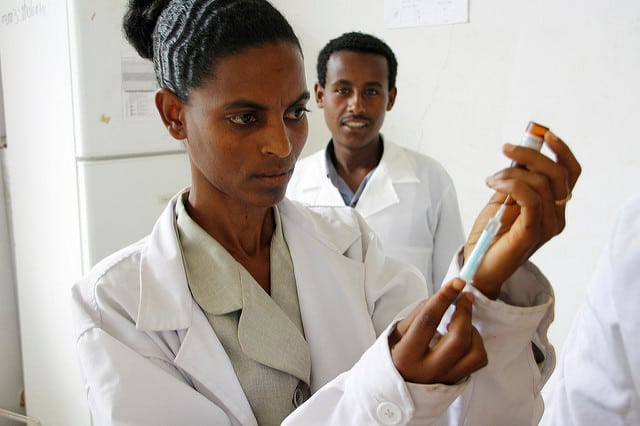January 21, 2017

A weekly roundup of news on drug resistance and other topics in global health.
Transmission-related infection with Extensively Drug-Resistant TB (XDR-TB) more common than development through selection pressure. A study in the New England Journal of Medicine finds that patients in South Africa more often contracted XDR-TB directly than developed further resistance after inadequate treatment of multidrug-resistant TB (MDR-TB). Patient interviews and social network analyses revealed transmission patterns involving 404 patients with XDR-TB, finding that 61 percent of patients had not received any previous treatment for MDR-TB. At most, the study finds, inadequate treatment of MDR-TB accounted for 31 percent of cases, far less than expected. Preventing XDR-TB requires entirely different strategies depending on how it arises. The study points to a need to shift emphasis toward strategies to prevent person-to-person transmission. [NEJM, STAT]
CRE more diverse genetically and transmitted through more pathways than previously thought. Carbapenem-resistant Enterobacteriaceae (CRE), a family of bacteria causing some of the most serious infections and resistant to several classes of antibiotics, are more genetically diverse than previously assumed, which suggests that Enterobacteriaceae develop resistance more easily. Findings published in the Proceedings of the National Academy of Sciences also point to a role for asymptomatic carriage in the evolution and spread of CRE. The 250+ samples sequenced came from patients at three Boston-area hospitals and one in San Francisco. Few of the isolates appeared to be genetically related, but carried a wide variety of genetic traits conferring resistance that can transfer easily between CRE species. [PNAS, CIDRAP]
CEPI, new global research and development organization for epidemic preparedness. Coalition for Epidemic Preparedness Innovations, launched this week at the World Economic Forum’s 2017 meeting, aims to fill the current need for a mechanism to facilitate globally pooled funding of research and development for epidemic preparedness. CEPI has two main objectives: advance vaccine candidates against priority pathogens, and build institutional platforms to accelerate the research and development response to pathogen emergencies. CEPI will first address Middle East respiratory syndrome coronavirus (MERS), Nipah virus, and Lassa fever, which are on WHO’s list of emerging pathogens likely to become problems in the near future. CEPI will retain funding to respond to yet unknown threats, predicting that they will need to raise US $1 billion over five years to operate effectively. [Lancet, NEJM]
Africa Centres for Disease Control and Prevention (Africa CDC) near launch date. The African Union’s Africa Agenda 2063 lays out the arguments for an Africa-wide public health agency. These include antimicrobial resistance and increasing population movement across Africa, with increased potential for new or reemerging pathogens to fuel pandemics. The Africa CDC will work with member states, the World Health Organization, and partners to strengthen four priority areas: health-related surveillance, functional clinical and public health laboratory networks, support for emergency preparedness, and strengthened public health science for improved decision making. Another comment in Lancet Global Health reviews the current state of clinical laboratory capacity in Africa and the laboratories’ role in disease detection and monitoring antimicrobial resistance. [Lancet GH, Lancet GH]
Access to medicine issues highlighted. In “Access to Medicine Index – what about sustainability?”, in The Lancet, David Heymann highlights areas for improvement in measures of access to medicines, like the Access to Medicine Index. Heymann notes the importance of including generics producers in measures, particularly when measuring access to medicine in low- and middle- income countries.
In The New England Journal of Medicine, Suerie Moon revisits the the United Nations final report on access to medicine, released in September 2016, following the 2015 High Level Panel on Access to Medicines. Moon brings out key ideas in discussions of access to medicine, such as transparency in safety, efficacy, prices, patent status, sources of investment, and costs of developing lifesaving medicines. Moon writes that the report’s “greatest impact may be realized not through intergovernmental talks, but by stimulating public debate over ways of reforming the research-and-development system to better serve the global public interest.” [Lancet, NEJM]
Revised international guidelines for the treatment of sepsis. Guidelines developed by the Surviving Sepsis Campaign, Society of Critical Care Medicine, and European Society of Intensive Care Medicine, and endorsed by more than 30 additional organizations, have been revised every four years since 2004. The guidelines, published in JAMA, provide major recommendations for managing infection, managing resuscitation, mechanical ventilation in sepsis-related acute respiratory distress syndrome (ARDS) and formal improvement programs. Recommendations include administering broad-spectrum intravenous antibiotics as soon as possible for rapid-source infection control, as well as assessing patients daily for de-escalation, and narrowing therapy based on cultures or clinical improvement. [JAMA, CIDRAP]
Image via UK DFID (CC BY-SA 2.0)











